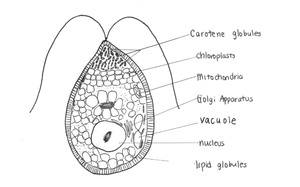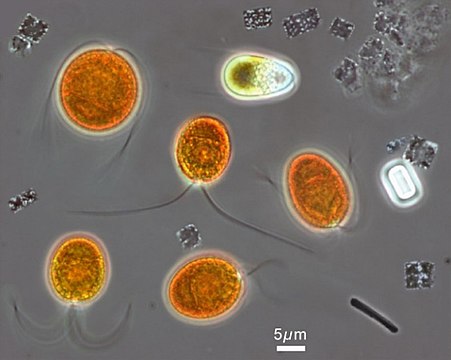Dunaliella Salina : Dunaliella Salina Cells In Different Culture Conditions A Green Cell Download Scientific Diagram
Dunaliella salina Chlorophyta and similar hypersaline strains have biflagellated pear-shaped cells. Die Verwendung einer solchen Creme schützt nicht nur vor äußeren Einflüssen sondern regeneriert die Haut und gibt ihr einen gesunden Teint.
Diese Laborstudie aus dem Jahr 2008 untersuchten Lungenkrebszellen die mit einem Extrakt aus Dunaliella behandelt worden waren.
Dunaliella salina. Sie ist bekannt dafür unter hohen Licht-und Salzkonzentrationen große Mengen an Beta-Carotin anzureichern. For the first time Milko 1963 reported that Dunaliella contains high concentrations of β-carotene and later it was also recommended as a commercial source of glycerol Ben-Amotz 1980. It provides a range of trace minerals and nutrients.
Dunaliella salina eine grüne Meeresalge ist in asiatischen Kulturen ein wichtiger Nahrungsbestandteil. Die ursprünglich grüne Alge wurde dadurch orangerot. Dunaliella salina is a unicellular green alga found in environments with high salt concentration.
Sie siedelt sich weltweit in sogenannten hypersalinen also sehr stark salz-haltigen Gewässern wie Salzsolen Salzverdampfungsteichen oder. Schönes Badevergnügen auch bei Neurodermitis Schuppenflechte Rheuma 65 2399 4798 kg. It was 67 years late in.
In Nahrungsergänzungen wird sie aufgrund ihres hohen Anteils an Carotinoiden und Beta- Carotin verwendet die sie während ihres Wachstums in großen Mengen bildet. Dunaliella salina is a genus of one-celled green microalgae first discovered in 1838 in southern France. This microalga is a natural source of carotenoids for some shrimps.
20 Bioactive compounds extracted from several algae and microalgae. Cremes die mit Beta-Carotin aus Dunaliella angereichert sind schützen die Haut vor Sonnenbrand und mindern das Hautkrebsrisiko. It is a whole food supplement.
However it was not named until 1905 by Teodoresco. Michel Felix Dunal first discovered D. Dunaliella salina is a photoautotroph although it is able to utilize organic C sources such as glycerol and acetate to some extent in light Suárez et al 1998.
They lack a rigid polysaccharide cell wall having instead a thin elastic plasma membrane. Besides SC-CO 2 extraction of γ-linolenic acid tocopherols and vitamin E from Spirulina platensis was studied as well. Salina is a unicellular biflagellate red-coloured alga which synthesises massive amounts of carotenoid pigments colouring the cells a very bright red.
Dunaliella Salina is a micro algae species. Dunaliella salina ist eine einzellige Alge und gehört zur Gruppe der Grünalgen. Nach 24 Stunden sank die Zellproliferation um 25 Prozent.
Nach weiteren 24 Stunden zeigte sich eine weitere Abnahme um 48 Prozent. What is The History of Dunaliella Salina. Die Dunaliella Salina ist wie es das Salina schon andeutet eine grüne teilweise bewegliche im Salzwasser wachsende Alge.
Die einzellige Alge lebt in hypersalinen Gewässern die bei Massenvorkommen rötlich gefärbt sind. Dunaliella salina is one of the most studied microalgae containing high amounts of β-carotene of about 14 of its dry weight followed by Chlorella vulgaris rich in carotenoids lutein and fatty acids. Mojaat et al 2008.
Beta-Carotin ist eins der über 400 in der Natur existierenden Carotinoide. Ihre Zellen färben sich von grün über orange bis dunkelrot. Bei hoher Salzkonzentration entwickelt die Dunaliella neben der Fotosynthese ein zweites Fotosystem um das Sonnenlicht zu verarbeiten.
Dunaliella salina ist eine Art der Gattung Dunaliella aus der Klasse der Chlorophyceae einer der beiden großen Gruppen von Grünalgen. Dunaliella produces β-carotene in high amounts up to 12 of dry matter. Die Duniella Alge ist ein reines Naturprodukt welches Ihrer Haut auch bei normalem Sonnenbaden einen zusätzlichen Schutz verleiht.
It produces a distinct pink and red colour often characteristic of saltern ponds. Encyclodedia of Life EOL multi. Large doses of Dunaliella may cause discoloration of the Skin which is.
It possesses Antioxidant Antiinflammatory Photoprotection Antiproliferative and Chemopreventive effects. Salina in 1838 in the south of France occupying. Dunaliella Salina is a non toxic Algae.
Dunaliella salina was first recognized by Teodoresco 1905. Dunaliella Salina ist eine einzellige Salzwasseralge und ist vor allem im Australischen Mittelmeer zu finden. Rosa Farbe der Sole dank Beta-Carotin aus der Mikroalge Dunaliella Salina.
In Laufe der Evolution hat die Dunaliella Salina Eigenschaften entwickelt große Mengen an Carotinoiden zu bilden. Michel Felix Dunal first discovered D. This alga is often found in natural marine habitats where it colours the water red.
It was first sighted in the saltern evaporation ponds of Montpellier on the Mediterranean coast in southern France. Ethanol extract of Dunaliella salina induces cell cycle arrest and apoptosis in A549 human non-small cell lung cancer cells. Carotinoide sind Farbstoffe die in zahlreichen Pflanzen auftreten.
2 It is often referred to as a halophile literally salt-loving alga because it.
Utex Lb 200 Dunaliella Salina Utex Culture Collection Of Algae

Dunaliella Salina Photograph By Steve Gschmeissner Science Photo Library
Italiano Dunaliella Salina Sistematica Etimologia Habitat Coltivazione
Analysis Of The Physiological And Molecular Responses Of Dunaliella Salina To Macronutrient Deprivation

Dunaliella Salina Photograph By Steve Gschmeissner Science Photo Library

Microscopic Picture Of Dunaliella Salina Download Scientific Diagram
Dunaliella Salina Sem Stock Image C029 7944 Science Photo Library

Dunaliella Salina The Alga That S Always Pretty In Pink Algae Research Supply
Utex Lb 1644 Dunaliella Salina Utex Culture Collection Of Algae
Dunaliella Salina The Alga That S Always Pretty In Pink Algae Research Supply

High Quality Dunaliella Salina Algae Powder Beta Carotene 3 China Dunaliella Salina Algae Powder Beta Carotene 3 Made In China Com

Dunaliella Salina Cells In Different Culture Conditions A Green Cell Download Scientific Diagram

Pdf The Unicellular Green Alga Dunaliella Salina Teod As A Model For Abiotic Stress Tolerance Genetic Advances And Future Perspectives






